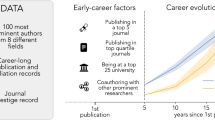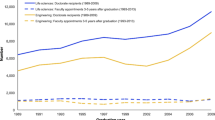Abstract
This paper examines how early career-related factors can predict the future research performance of computer and information scientists. Although a few bibliometric studies have previously investigated multiple factors relating to early career scientists that significantly predict their future research performance, there have been limited studies on early career-related factors affecting scientists in the fields of information science and computer science. This study analyzes 4102 scientists whose publishing careers started in the same year. The criteria used to quantify future research performance of the target scientists included the number of publications and citation counts of publications in a 4-year citation window to indicate future research productivity and research impact, respectively. These criteria were regressed on 13 early career-related factors. The results showed that these factors accounted for about 27% and 23% of the future productivity of the target scientists in terms of journal articles and conference papers, respectively; these 13 factors were also responsible for 19% of the future impact of target scientists’ journal articles and 19% of the future impact of their conference papers. The factor that most contributed to explaining the future research performance (i.e. publication numbers) and future research impact (i.e. citation counts of publications) was the number of publications (both journal articles and conference papers) produced by the target scientists in their early career years.



Similar content being viewed by others
References
Abramo, G., & D’Angelo, C. A. (2014). How do you define and measure research productivity? Scientometrics,101(2), 1129–1144.
Acuna, D. E., Allesina, S., & Kording, K. P. (2012). Predicting scientific success. Nature,489, 201.
Adam Holland, G. (2008). Information science: An interdisciplinary effort? Journal of Documentation,64(1), 7–23.
Aksnes, D. W. (2003). A macro study of self-citation. Scientometrics,56(2), 235–246.
Biscaro, C., & Giupponi, C. (2014). Co-authorship and bibliographic coupling network effects on citations. PLoS ONE,9(6), e99502.
Bornmann, L., Mutz, R., & Daniel, H.-D. (2008a). Are there better indices for evaluation purposes than the h index? A comparison of nine different variants of the h index using data from biomedicine. Journal of the American Society for Information Science and Technology,59(5), 830–837.
Bornmann, L., Wallon, G., & Ledin, A. (2008b). Does the committee peer review select the best applicants for funding? An investigation of the selection process for two European Molecular Biology Organization Programmes. PLoS ONE,3(10), e3480.
Bornmann, L., & Williams, R. (2017). Can the journal impact factor be used as a criterion for the selection of junior researchers? A large-scale empirical study based on ResearcherID data. Journal of Informetrics,11(3), 788–799.
Carayol, N., & Matt, M. (2004). Does research organization influence academic production?: Laboratory level evidence from a large European university. Research Policy,33(8), 1081–1102.
Cohen, J., Cohen, P., West, S. G., & Aiken, L. S. (2013). Applied multiple regression/correlation analysis for the behavioral sciences. New York: Routledge.
Colugnati, F. A., Carneiro, A. M., & Salles Filho, S. (2011). Multidimensional evaluation of a program for early-career researcher in Brazil-the Young Investigator in Emerging Centers program. In 2011 Atlanta conference on science and innovation policy, 2011 (pp. 1–8). IEEE.
Costas, R., & Bordons, M. (2011). Do age and professional rank influence the order of authorship in scientific publications? Some evidence from a micro-level perspective. Scientometrics,88(1), 145–161.
Dong, Y., Johnson, R. A., & Chawla, N. V. (2015). Will this paper increase your h-index?: Scientific impact prediction. In Proceedings of the eighth ACM international conference on web search and data mining, 2015 (pp. 149–158). ACM.
Frandsen, T. F., & Nicolaisen, J. (2012). Effects of academic experience and prestige on researchers’ citing behavior. Journal of the American Society for Information Science and Technology,63(1), 64–71.
García-Pérez, M. A. (2013). Limited validity of equations to predict the future h index. Scientometrics,96(3), 901–909.
Guan, J., Yan, Y., & Zhang, J. J. (2017). The impact of collaboration and knowledge networks on citations. Journal of Informetrics,11(2), 407–422.
Han, P., Shi, J., Li, X., Wang, D., Shen, S., & Su, X. (2014). International collaboration in LIS: Global trends and networks at the country and institution level. Scientometrics,98(1), 53–72.
Havemann, F., & Larsen, B. (2015). Bibliometric indicators of young authors in astrophysics: Can later stars be predicted? Scientometrics,102(2), 1413–1434.
Hirsch, J. E. (2007). Does the h index have predictive power? Proceedings of the National Academy of Sciences,104(49), 19193.
Hönekopp, J., & Khan, J. (2012). Future publication success in science is better predicted by traditional measures than by the h index. Scientometrics,90(3), 843–853.
Hu, Z., Chen, C., & Liu, Z. (2014). How are collaboration and productivity correlated at various career stages of scientists? Scientometrics,101(2), 1553–1564.
Huang, M.-H., & Chang, Y.-W. (2011). A study of interdisciplinarity in information science: Using direct citation and co-authorship analysis. Journal of Information Science,37(4), 369–378.
Jensen, P., Rouquier, J.-B., & Croissant, Y. (2009). Testing bibliometric indicators by their prediction of scientists promotions. Scientometrics,78(3), 467–479.
Jin, B. (2006). H-index: An evaluation indicator proposed by scientist. Science Focus,1(1), 8–9.
Kademani, B., Kumar, V., Surwase, G., Sagar, A., Mohan, L., Gaderao, C., et al. (2005). Scientometric dimensions of innovation communication productivity of the Chemistry Division at Bhabha Atomic Research Centre. Malaysian Journal of Library & Information Science,10(1), 65–89.
Keith, T. Z. (2014). Multiple regression and beyond: An introduction to multiple regression and structural equation modeling. New York: Routledge.
Kim, J. (2019). Author-based analysis of conference versus journal publication in computer science. Journal of the Association for Information Science and Technology,70(1), 71–82.
Kousha, K., & Thelwall, M. (2007). Google Scholar citations and Google Web/URL citations: A multi-discipline exploratory analysis. Journal of the American Society for Information Science and Technology,58(7), 1055–1065.
Larivière, V., Sugimoto, C. R., & Cronin, B. (2012). A bibliometric chronicling of library and information science’s first hundred years. Journal of the American Society for Information Science and Technology,63(5), 997–1016.
Lee, D. H. (2019). Predictive power of conference-related factors on citation rates of conference papers. Scientometrics,118(1), 281–304.
Levitt, J. M., & Thelwall, M. (2016). Long term productivity and collaboration in information science. Scientometrics,108(3), 1103–1117.
Li, E. Y., Liao, C. H., & Yen, H. R. (2013). Co-authorship networks and research impact: A social capital perspective. Research Policy,42(9), 1515–1530.
Lindahl, J. (2018). Predicting research excellence at the individual level: The importance of publication rate, top journal publications, and top 10% publications in the case of early career mathematicians. Journal of Informetrics,12(2), 518–533.
Lindahl, J., & Danell, R. (2016). The information value of early career productivity in mathematics: A ROC analysis of prediction errors in bibliometricly informed decision making. Scientometrics,109(3), 2241–2262.
Lisée, C., Larivière, V., & Archambault, É. (2008). Conference proceedings as a source of scientific information: A bibliometric analysis. Journal of the American Society for Information Science and Technology,59(11), 1776–1784.
McCarty, C., Jawitz, J. W., Hopkins, A., & Goldman, A. (2013). Predicting author h-index using characteristics of the co-author network. Scientometrics,96(2), 467–483.
Monge, P. R., & Contractor, N. S. (2003). Theories of communication networks. Oxford: Oxford University Press.
Nederhof, A. J. (2006). Bibliometric monitoring of research performance in the social sciences and the humanities: A review. Scientometrics,66(1), 81–100.
Newman, M. E. J. (2004). Coauthorship networks and patterns of scientific collaboration. Proceedings of the National Academy of Sciences,101(suppl 1), 5200–5205.
Onodera, N., & Yoshikane, F. (2015). Factors affecting citation rates of research articles. Journal of the Association for Information Science and Technology,66(4), 739–764.
Pasterkamp, G., Rotmans, J., de Kleijn, D., & Borst, C. (2007). Citation frequency: A biased measure of research impact significantly influenced by the geographical origin of research articles. Scientometrics,70(1), 153–165.
Penner, O., Pan, R. K., Petersen, A. M., Kaski, K., & Fortunato, S. (2013). On the predictability of future impact in science. Scientific Reports,3, 3052.
Petersen, A. M., Jung, W.-S., Yang, J.-S., & Stanley, H. E. (2011). Quantitative and empirical demonstration of the Matthew effect in a study of career longevity. Proceedings of the National Academy of Sciences,108(1), 18–23.
Procter, R., Williams, R., Stewart, J., Poschen, M., Snee, H., Voss, A., et al. (2010). Adoption and use of Web 2.0 in scholarly communications. Philosophical Transactions of the Royal Society A: Mathematical, Physical and Engineering Sciences,368(1926), 4039–4056.
Schreiber, M. (2007). Self-citation corrections for the Hirsch index. EPL (Europhysics Letters),78(3), 30002.
Symonds, M. R., Gemmell, N. J., Braisher, T. L., Gorringe, K. L., & Elgar, M. A. (2006). Gender differences in publication output: Towards an unbiased metric of research performance. PLoS ONE,1(1), e127.
Tahamtan, I., Safipour Afshar, A., & Ahamdzadeh, K. (2016). Factors affecting number of citations: A comprehensive review of the literature. Scientometrics,107(3), 1195–1225.
Takeda, Y., & Kajikawa, Y. (2010). Tracking modularity in citation networks. Scientometrics,83(3), 783–792.
Thelwall, M., & Wilson, P. (2014). Regression for citation data: An evaluation of different methods. Journal of Informetrics,8(4), 963–971.
Thunnissen, M., Boselie, P., & Fruytier, B. (2013). Talent management and the relevance of context: Towards a pluralistic approach. Human Resource Management Review,23(4), 326–336.
Uddin, S., Hossain, L., & Rasmussen, K. (2013). Network effects on scientific collaborations. PLoS ONE,8(2), e57546.
Waltman, L. (2016). A review of the literature on citation impact indicators. Journal of Informetrics,10(2), 365–391.
Waltman, L., & Van Eck, N. J. (2009). A taxonomy of bibliometric performance indicators based on the property of consistency. Paper presented at the Proceedings of the 12th international conference on Scientometrics and Informetrics.
Waltman, L., van Eck, N. J., & Wouters, P. (2013). Counting publications and citations: Is more always better? Journal of Informetrics,7(3), 635–641.
Acknowledgements
I would like to express my deep gratitude to the anonymous reviewer for his/her detailed and insightful comments, which have improved the overall quality of this manuscript.
Author information
Authors and Affiliations
Corresponding author
Rights and permissions
About this article
Cite this article
Lee, D.H. Predicting the research performance of early career scientists. Scientometrics 121, 1481–1504 (2019). https://doi.org/10.1007/s11192-019-03232-7
Received:
Published:
Issue Date:
DOI: https://doi.org/10.1007/s11192-019-03232-7




